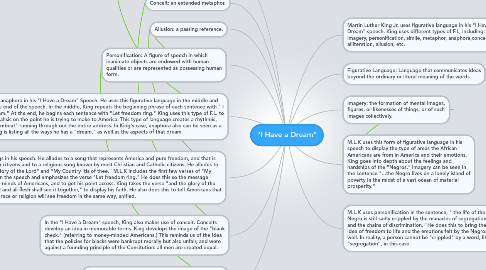"I Have a Dream"
by Eliana Goldberg

1. Martin Luther KIng Jr. uses figurative language in his "I Have a Dream" speech. King uses different types of F.L, including: imagery, personification, simile, metaphor, anaphora,conceit, alliteration, allusion, etc.
2. Figurative Language: Language that communicates ideas beyond the ordinary or literal meaning of the words
3. Imagery: the formation of mental images, figures, or likenesses of things, or of such images collectively.
4. M.L.K uses this form of figurative language in his speech to display the type of areas the African Americans are from in America and their emotions. King goes into depth about the feelings and hardships of the "Negros." Imagery can be seen in the sentence "...the Negro lives on a lonely island of poverty in the midst of a vast ocean of material prosperity."
5. Anaphora: the repititon of words, phrases, or clauses in successive lines, stanzas, or paragraphs.
6. Conceit: an extended metaphor.
7. Allusion: a passing reference.
8. Personification: A figure of speech in which inanimate objects are endowed with human qualities or are represented as possessing human form.
9. M.L.K uses anaphora in his "I Have a Dream" Speech. He uses this figurative language in the middle and towards the end of the speech. In the middle, King repeats the beginning phrase of each sentence with " I have a dream." At the end, he begins each sentence with "Let freedom ring." King uses this type of F.L. to create empahsis on the point he is trying to make to America. This type of language creates a rhythmic, verbal "drumbeat" running through out the entire address. In King's case, anaphora also can be seen as a theme. King is listing all the ways he has a "dream," as well as the aspects of that dream.
10. M.L.K references songs in his speech. He alludes to a song that represents America and pure freedom, and that is known to all American citizens and to a religious song known by most Christian and Catholic citizens. He alludes to the songs "And the Glory of the Lord" and "My Country 'tis of thee." M.L.K includes the first few verses of "My Country 'tis of thee" in the speech and emphasizes the verse "Let freedom ring." He does this so the message flows and sticks in the minds of Americans, and to get his point across. King takes the verse "and the glory of the Lord shall be revealed and all flesh shall see it together," to display his faith. He also does this to tell Americans that all citizens, no matter race or religion will see freedom in the same way, unified.
11. In the "I Have a Dream" speech, King also makes use of conceit. Conceits develop an idea in memorable terms. King develops the image of the "blank check." (referring to money-minded Americans.) This reminds us of the idea that the policies for blacks were bankrupt morally but also unfair, and were against a founding principle of the Consitution: all men are created equal.
12. M.L.K uses personification in the sentence, " the life of the Negro is still sadly crippled by the manacles of segregation and the chains of discrimination." He does this to bring the idea of freedom to life and the emotions felt by the Negros as well. In reality, a person cannot be "crippled" by a word, like "segregation", in this case.
13. M.L.K uses personification in the sentence, " the life of the Negro is still sadly crippled by the manacles of segregation and the chains of discrimination." He does this to bring the idea of freedom to life and the emotions felt by the Negros as well. In reality, a person cannot be "crippled" by a word, like "segregation", in this case.


